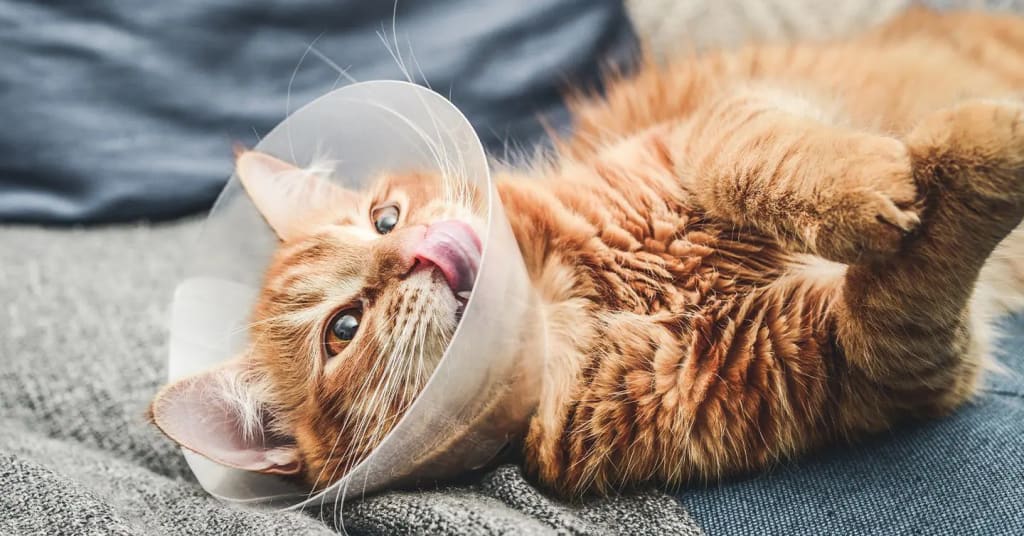"Unbelievable Transformation: Watch How Neutering a Cat Changes Everything!"
"From Spraying to Snuggles - The Jaw-Dropping Effects of Cat Neutering Revealed!"

Cat neutering, also known as castration, is a common surgical procedure performed on male cats to remove their testicles. This procedure has numerous benefits for both the cat and the broader community.
One of the primary reasons for neutering is to control the cat population. Uncontrolled breeding can lead to an overpopulation of stray cats, which can cause a range of issues, including the spread of diseases and environmental disruption. Neutering helps prevent unwanted litters and reduces the number of cats ending up in animal shelters or living on the streets.
Apart from population control, neutering also has positive effects on a cat's behavior. Male cats that are not neutered are often more territorial and prone to aggressive behavior. They may spray urine to mark their territory, which can be an unpleasant and challenging habit to manage. Neutering can significantly reduce or eliminate such behaviors, making the cat more pleasant to live with and reducing the likelihood of conflicts with other pets in the household.
Furthermore, neutering can diminish the cat's roaming tendencies. Unneutered male cats are driven by their hormones to seek out females, leading them to wander far from home in search of potential mates. This roaming behavior puts them at risk of accidents, injuries, and exposure to various dangers. Neutering can help curb this instinct, encouraging the cat to stay closer to home and reducing the chances of encountering hazardous situations.
It's essential to note that neutering is a routine and safe procedure when performed by a qualified veterinarian. The cat is placed under anesthesia during the surgery, and post-operative care instructions are provided to ensure a smooth recovery.
cat neutering, or castration, is a responsible and beneficial decision for both the individual cat and the overall feline population. By addressing behavior and reproductive issues, neutering helps create a safer, healthier, and more harmonious environment for cats and their human companions.
1. Health Benefits:
Besides controlling behavior and preventing unwanted litters, neutering also provides health benefits for male cats. It reduces the risk of certain reproductive organ diseases, such as testicular cancer and prostate problems. Neutered cats are also less likely to develop certain behavioral issues associated with mating instincts, which can sometimes lead to stress-related health problems.
2. Age of Neutering:
It is generally recommended to neuter cats at a young age, usually around 4 to 6 months old. Neutering at this stage is safe and effective, and it helps prevent the cat from developing unwanted mating behaviors before they become ingrained habits.
3. Procedure and Recovery:
Cat neutering is a relatively simple surgical procedure. The cat is placed under general anesthesia during the operation, ensuring they feel no pain or discomfort. The veterinarian makes a small incision in the scrotum to remove the testicles. After the surgery, the cat is closely monitored during recovery, and pain relief is provided as needed to ensure a comfortable healing process.
4. Impact on Females:
It's essential to note that neutering is specific to male cats and involves the removal of their testicles. For female cats, the equivalent procedure is called spaying, which involves the removal of their ovaries and uterus. Spaying also has many benefits, including preventing unwanted pregnancies and reducing the risk of certain reproductive health issues.
5. Behavioral Changes:
While neutering can address some undesirable behaviors in male cats, it is not a "magic fix" for all behavioral problems. Some behaviors may have developed as a result of other factors, such as environmental stress or past experiences. In such cases, additional training and environmental enrichment may be needed to address the behavioral issues fully.
6. Post-Neutering Care:
After the neutering procedure, the cat may need some time to recover fully. It's essential to follow the veterinarian's post-operative care instructions carefully, which may include limiting physical activity, providing a comfortable and quiet space for rest, and monitoring the surgical site for any signs of infection.
7. Behavioral Changes After Neutering:
Neutering can lead to positive behavioral changes in male cats. As the production of testosterone decreases after the procedure, male cats tend to become more relaxed and less aggressive. They are also less likely to engage in territorial marking behavior, such as spraying urine around the house. Neutered cats often exhibit increased affection towards their owners and may become more social with other pets in the household.
8. Prevention of Roaming and Fighting:
Unneutered male cats have a strong instinct to roam in search of potential mates. This behavior can lead to dangerous situations, such as crossing busy roads or getting into fights with other male cats over territory or females. Neutering can significantly reduce the urge to roam and minimize the risk of these dangerous encounters, promoting the safety and well-being of the cat.
9. Reducing the Chance of Reproductive Health Issues:
Neutering eliminates the risk of certain reproductive health problems in male cats, such as testicular tumors and infections. These conditions can be painful and potentially life-threatening if left untreated. By removing the testicles through neutering, these risks are entirely eliminated.
10. Contributing to Community Well-being:
Cat neutering plays a crucial role in maintaining a balanced and healthy community of cats. By preventing overpopulation, it reduces the strain on animal shelters and rescues. Additionally, it helps minimize the impact of feral cat colonies on local ecosystems and wildlife.
11. Timing and Fertility:
It's important to note that even after neutering, male cats can still be fertile for a short period. Sperm can remain in their reproductive tracts for some time, so it's crucial to keep newly neutered cats away from unspayed females to prevent any accidental pregnancies.
12. Cost and Affordability:
Some pet owners may be concerned about the cost of the neutering procedure. However, many communities and animal welfare organizations offer low-cost or subsidized neutering programs to make it more accessible for everyone. It's worth researching such programs in your area to ensure responsible pet ownership without financial burden.
13. Psychological Benefits:
Neutering can have positive psychological effects on male cats. It can help reduce stress and anxiety, as mating instincts and the need to find a mate are diminished. Neutered cats are often more content and less driven by hormonal urges, leading to a calmer and more stable temperament.
14. Prevention of Spraying:
Unneutered male cats are more likely to engage in urine spraying, a behavior where they mark their territory by releasing small amounts of urine on vertical surfaces. This behavior can be a significant source of frustration for cat owners and may lead to unpleasant odors in the home. Neutering can significantly reduce or eliminate spraying behavior, making the indoor environment more pleasant for everyone.
15. Neutering and Aggression:
Neutering can be an effective way to address certain aggressive behaviors in male cats. Testosterone plays a role in promoting territorial aggression, and by reducing its levels through neutering, cats are less likely to engage in aggressive behaviors towards other animals and even humans.
16. Promoting Responsible Pet Ownership:
By neutering your male cat, you are actively participating in responsible pet ownership. Spaying and neutering are critical steps in controlling the pet population and ensuring that all cats have loving homes. Responsible pet owners also contribute to reducing the burden on animal shelters and rescue organizations, allowing them to focus their resources on caring for animals in need.
17. Encouraging Longer Lifespan:
Neutering is associated with a longer lifespan for male cats. Neutered cats are less likely to engage in risky behaviors related to mating, such as fights with other males, roaming into dangerous areas, or contracting diseases from mating encounters. This reduced risk of accidents and injuries can lead to a longer and healthier life for your feline companion.
18. Easy Integration:
Neutered male cats tend to integrate more easily into multi-cat households. They are less likely to display dominant behaviors, reducing the potential for conflicts with other cats in the home.
19. Positive Influence on Female Cats:
Neutering male cats can have a positive impact on female cats as well. By reducing the number of intact males in the area, the chances of unwanted pregnancies are decreased, contributing to better feline welfare overall.
20. Spaying and Neutering for Stray Cats:
In addition to neutering pet cats, spaying and neutering stray and feral cats are essential for managing their population. TNR (Trap-Neuter-Return) programs are widely used to control stray cat populations in many communities, providing a humane and effective method to curb overbreeding and improve the lives of these cats.
In summary, cat neutering offers numerous benefits, including improved behavior, reduced roaming and spraying tendencies, prevention of reproductive health issues, and a positive impact on the broader feline community. It is a responsible and caring decision that promotes the well-being of your cat and contributes to the welfare of all cats. Always consult with a veterinarian to discuss the best options for your cat and to ensure a safe and successful neutering procedure.
About the Creator
Go With Trend
"Express, Connect, Impact - Welcome to "Go With Trend"!
Discover the magic of Letters on our vibrant platform. 🎙️ Share stories, sing your heart out, and connect with a global audience. 🌍 Unleash your creativity today! ✨ #"Go With Trend"






Comments
There are no comments for this story
Be the first to respond and start the conversation.